Please click here to access the main AHDB website and other sectors.
- Home
- Knowledge library
- Management of botrytis in cut flower peony crops
Management of botrytis in cut flower peony crops
Botrytis is one of the most economically significant pathogens affecting peony, and can result in crop losses in excess of 20% during wet years.
Management of the disease is reliant on cultural control, site hygiene measures and fungicides. Several botrytis species are known to infect peony, including Botrytis paeoniae, Botrytis cinerea, Botrytis pseudocinerea and Botrytis euroamericana. Generally, B. paeoniae is responsible for early blight and is considered specific to peony, while B. cinerea and B. pseudocinerea are responsible for late blight.
Developing in the spring, botrytis is a recurrent problem for all peony growers, especially during wet periods where the disease can be very prevalent. Infections affect new shoots and foliage leading to bud abortion or unsightly and unmarketable blooms. As a perennial crop, inoculum levels will accumulate over time where not addressed, increasing losses. Severe outbreaks can lead to the loss of a large proportion of young stems, as well as affecting the developing buds/blooms. Post-harvest losses are also a problem where symptoms develop on buds/blooms in retail stores.
Disease symptoms
Botrytis can develop on almost all plant tissues, at every developmental stage. Early in the season, the presence of inoculum sources at stem emergence enables early blight infections to develop almost immediately. Infected young shoots suddenly wilt and fall over due to lesions, which can fully girdle stems. On well-developed lesions, under conducive climatic conditions, spore-bearing structures emerge, shedding spores for further infection.
Flowers are the most susceptible tissue type to botrytis infection and can be infected from the earliest stages of bud development. Bud blast (early blight) develops on small young buds, where infection causes them to blacken and fail to open.
Mature buds can also become infected, failing to open, or only partially open. Individual petals may become infected, starting as brown spots before coalescing to cover the entire petal, eventually taking on a papery, dry appearance. During favourable conditions of leaf wetness, a velvety grey mass of fungal spores will develop which can rapidly cover part of, or all of the bud. Further infection can develop down the flower neck, and after time the infected bloom may fall away.
Infected stems which do not collapse early, develop a tan appearance with concentric rings which can fully girdle the stem. In situations where leaves become infected, large irregular concentric brown leaf spots develop, often from the leaf tip spreading inwards.
Late blight infections differ from those of early blight. Typically affecting late opening flowers, the fungal growth is more diffuse than the tight fungal growth in early blight infections (see images).
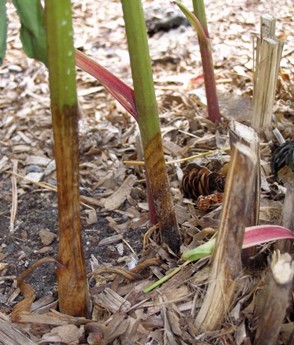
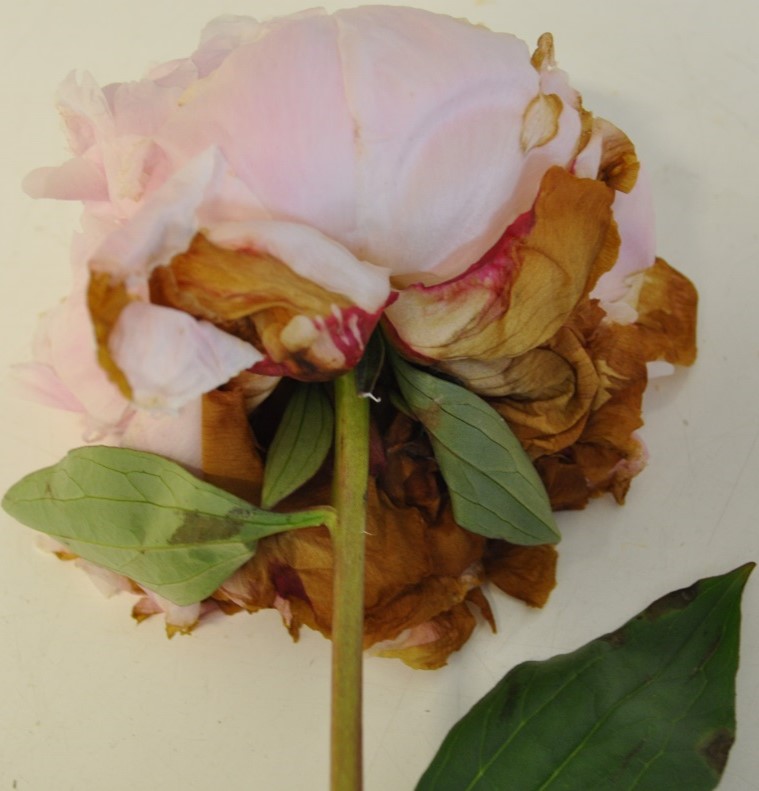
Infected stems with a tan appearance and lesions which fully girdle the stem base, Source: Michelle Grabowski, University of Minnesota Extension - Horticulture, Bugwood.org
Brown and papery petals as a consequence of botrytis infection, Source: ADAS Horticulture
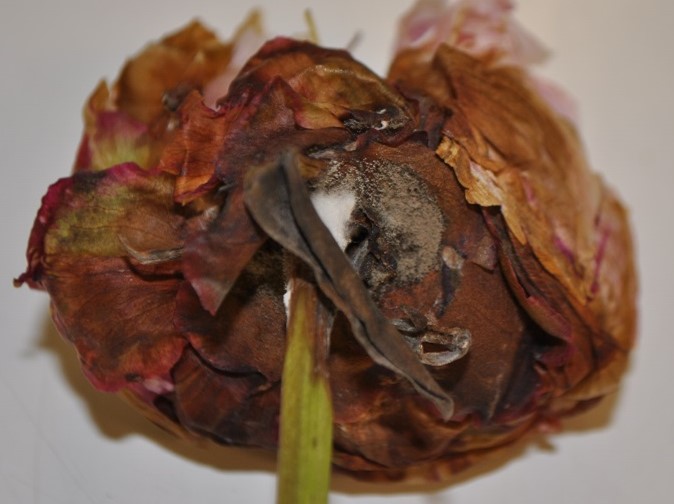
Velvety grey botrytis sporulation at the flower base, Source: ADAS Horticulture
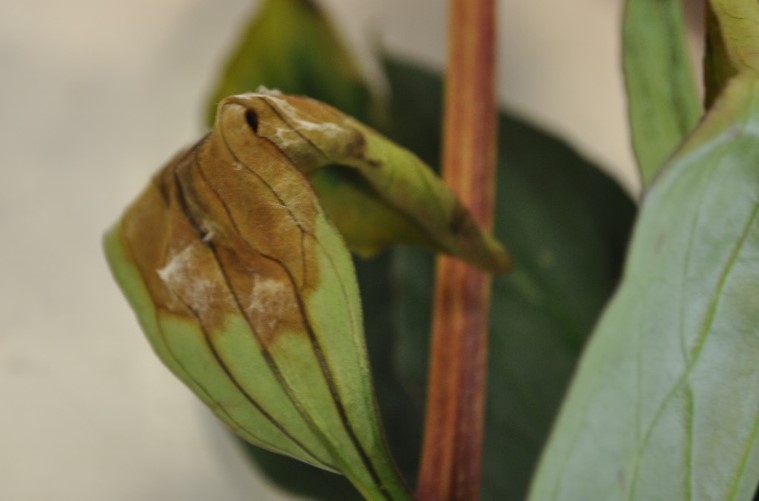
Early botrytis sporulation and tissue browning on infected peony leaf, Source: ADAS Horticulture
Sources of infection
Botrytis is a near ubiquitous fungus producing huge quantities of airborne spores which are present in almost all environments. The perennial nature of peony cultivation allows for accumulation of botrytis species over time and this must be managed to limit losses. Planting densities, soil types and environmental conditions at planting and during growing on all vary for UK crops. Higher planting densities result in more frequent botrytis infection, especially on more susceptible varieties such as Flame, Command Performance, Miss America, Lemon Chiffon, Madame Claude Tain, Duchesse De Nemours and others. Majority of the UK peony crop is grown on medium to heavy soils which tend to favour botrytis accumulation over the years. Mature crops therefore have higher botrytis disease pressure than more recent younger plantations. Flail mowing and pulverising last years crop in the autumn is linked with higher incidence of botrytis compared with trimming the stems as they senesce and moving the crop residues out of the fields.
Two species of botrytis are confirmed to infect peony in the UK, however a greater diversity of botrytis species may also cause disease.
Botrytis paeoniae: This pathogen is responsible for early blight (bud blast) and is believed to be specific to peony. It typically causes symptoms in the UK between week 6 and week 14-15 (mainly on very early and early varieties). B. paeoniae is likely to originate be from propagative materials, with transmission of the pathogen from equipment and machinery used at other peony production sites also possible. Longer term inoculum sources include crop debris and a range of weeds present in field boundaries or from within the crops. Various annual (annual mercury, groundsel, fat het) and perennial (thistles, docks, dandelions etc) weed species are also known to act as interim hosts, where botrytis spores are resting on living or senesced weed tissue until shoot elongation stage in peony begins in late winter and early spring. The Netherlands experience refers to botrytis being mainly found on the soil surface on decaying plant material and the advice there is targeted at pesticide applications with high water volumes around the crowns of the plants.
Botrytis cinerea: Responsible for late blight, B. cinerea can overwinter in debris. It has a wide temperature range for infection of between 3°C and 25°C. B. cineria is considered to be a weak pathogen which requires nutrients (leaking from a wound or dying tissue, bruising) before it can invade a plant. The spores of botrytis can germinate in 3 hours when relative humidity (RH) is 95% or above and reducing RH can delay spore germination. Infections are typically found between week 13 and week 20-22 in the UK. All varieties can be infected but usually whites and doubles or bomb types are more susceptible. B. cinerea inoculum may also be introduced to peony from nearby host weed species. This pathogen tends to be more opportunistic and generally occurs in plantings where de-budding has been carried out too late, in wet weather conditions or where the mechanical process of de-budding has been too robust and multiple physical bruising has occurred on the flower stems near the dominant buds. Late spring frosts, continuous wet weather and wind as well as hail damage all significantly increase the likelihood of B. cinerea infection. Late blight is much more variety specific in comparison to early blight, mainly due to the structural differences in tissue development in different varieties.
Management strategies
Similar to all botrytis outbreaks on ornamental plants, management of peony botrytis is most difficult during, or following wet seasons. Once emerged, peonies grow rapidly and are not resilient to sudden environmental changes. The rapid speed of growth reduces plant tissue dry matter accumulation and increases water content resulting in weakened tissue, it also reduces tissue concentrations of rapidly absorbed crop protection products and increases the risk of damage from adverse climate such as frost and wind. The factors combined mean the peony crop is vulnerable to rapid early blight botrytis infections. Adequate nutrition, cultural and site hygiene measures in combination with fungicide applications, provide the most effective control strategy.
Variety selection
Variety choice is a key component of any control strategy and the use of tolerant, or resistant varieties can significantly reduce the requirement for fungicide inputs. However, there is little information on the relative susceptibilities of peony varieties to botrytis. The popular variety ‘Sarah Bernhardt’ claims full resistance by some, but is described as moderately resistant by others. Several growers claim that vigorously growing varieties, and those with thicker stems, are more susceptible to botrytis, however no published work investigating this is available. Intersectional varieties, hybrids between herbaceous and tree peonies are also considered to have greater resistance, but are less suitable for cut flowers, as blooms from these types have a shorter vase life. However, for most large commercial plantings, the main factors impacting varietal selection are yield and cost of tubers. More recently growers are also choosing varieties that help to extend the cropping season at both ends (very early and very late flowering varieties) to secure continuity of supply and better margins. Many of the early varieties are particularly prone to frosts and therefore are often in the susceptible or moderately susceptible group.
Peony variety botrytis susceptibility from UK experience:
| Susceptible | Moderately susceptible | Considered tolerant |
| Flame, Command Performance, Miss America, Lemon Chiffon, Madame Claude Tain, Duchesse De Nemours, Alertie, Vogue, Bowl of Cream, Blushing Princess, Pecher | Sarah Bernhardt, Red Sarah Bernhardt, Dr. Alexander Fleming, Shirley Temple, Red Charm, Coral Charm, Coral Sunset, Karl Rosenfield, Solange, Jules Elie, Kansas, Amabilis, Many Happy Returns, Etched Salmon, Bowl of Beauty, Belgravia | Gardenia, Festiva Maxima, Lady Alexandra Duff, Jacorma, Peter Brand, Old Faithful, Immaculee, Elsa Sass, Henry Bockstoce |
Cultural control and site hygiene measures
A range of cultural control and site hygiene measures are available which can reduce sources of botrytis inoculum and limit crop damage. The following lists best practice recommendations for managing botrytis in peony.
Leaf wetness: Only relevant for the small number of UK peony crops grown under temporary or permanent polytunnels and glasshouses. Reducing leaf wetness is essential for the control of this pathogen.
Start clean: Ensure all planting material is disease free to avoid introducing the pathogen at planting, using stock from reputable suppliers.
Site selection: Peonies are planted once and then remain in situ for minimum of 20 years in place so spend some time to get it right from the word go. Target optimum times for planting in autumn as prolonged storage of tubers in cold stores or in sheds reduces the plants defence mechanism as the bud initiation starts once the chilling hours are achieved for each variety. Reduce plant density and consider planting direction in relation to prevailing winds in spring. Planting rows should ideally be with NS, NSE or NSW exposure. Site crops in an open situation away from tall hedgerows and residential buildings which will improve airflow, reduce periods of leaf wetness and eliminate shading effects. Avoid areas which frequently receive late spring frosts or high winds to reduce crop damage. Prior to planting, ensure field drainage is addressed as well as adopt stale seed bed technique to remove as much as possible of the weed seed bank in the soil from previous cropping.
Mulching & Fleecing: It is not recommended to mulch peony crops as this often encourages Botrytis and can in some cases abort flower formation. Farmyard manure has been implicated with favouring botrytis establishment and should be avoided. Fleecing the crop to bring forward peony crop flowering. It is important to choose the correct fleece density and material as some types of fleece are abrasive and can cause damage to emerging shoots. The process of covering crops and of removing fleece can often cause wounds and bruising to the shoots and encourage botrytis.
Weed and debris removal: A robust pre-emergence herbicide programme is required to control weeds, improve airflow around the base of plants and to remove potential botrytis inoculum sources. In early autumn (mid-September) all plant material should be cut back to, roughly 10 cm above the soil, with the debris removed and destroyed away from the field.
Removal of infected material: Ideally remove young, infected shoots in the spring as soon as wilting appears. Infected buds, and other infected material should be removed during the de-budding process and harvest. Any crops with infections the previous year will most likely carry greater risk into following year, especially if the following spring is wet and cool. Often a significant source of botrytis comes through the fructose rich sap oozing out of the buds and most of the time being colonised by sooty moulds but in some cases the sap is rich in sugars and therefore encourage botrytis development.
Bloom avoidance: Petals are highly vulnerable to botrytis infection and once infected can act as secondary disease sources as a consequence of petal stick. Avoid flower bloom in fields, or remove heads before petal fall, ideally removing the flower buds that will not be harvested at the same time as cutting the marketable stems, ensuring that flower petals cannot develop. This will reduce post-harvest losses through reduced inoculum levels on harvested buds.
Harvest: Use sharp, clean blades to harvest flower buds and frequently disinfected these in use using a product known to be effective against botrytis. Ensure leaf litter is removed during the harvest or soon after to avoid a build-up of decaying matter around the base of the plants which will increase the risk of infection for next year.
Post-harvest: Maintain low relative humidities and avoid fluctuations in post-harvest stores. Cropping wet stems often results in post-harvest botrytis development in cold store or in packed product in retailer stores.
Growing season & aftercare: adequate nutrition is required annually, especially for newly planted and mature crops, so annual soil sampling and fertiliser management planning is paramount for effective botrytis control. Generally granular fertiliser applications are made before shoot extension growth, however, if the growth has already started, some agricultural machinery spreaders can cause damage to new shoots from the physical force of the granules hitting the plants. The damage can often be seen weeks after application and appears as leaf spotting. In most cases this damage does not affect marketability but it result in increased botrytis infections. Potassium and Calcium play a key role in the tolerance of peony crops to botrytis. Ensure half of the annual requirement of potassium is delivered before start of growth and the other half of after harvest. Calcium is required particularly during the shoot extension growth stage and regular calcium foliar sprays are beneficial. It is a good practice to add trace elements and some nitrogen during the bud formation stage to enlarge the flower buds and improve colouring.
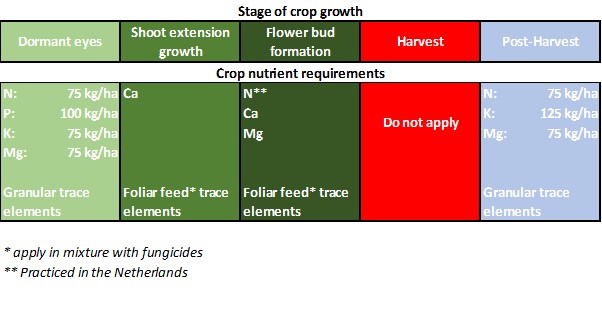
Crop protection products
Fungicides
As botrytis can infect plants at stem emergence, timely and preventative application of fungicides is essential for effective management. The degree of chemical control required will be dependent on environmental conditions, the age of the crop and the severity of the disease in the previous season.
Many fungicides are available to treat peony botrytis, covering multiple active ingredients and several modes of action. Over the course of a season, a peony crop is likely to receive five or more fungicide applications for botrytis control, dependent on conditions and varietal susceptibility. The first fungicide application should be a preventative, systemic treatment, applied at stem emergence to protect developing shoots, this targets B. paeoniae.
Further fungicide applications may be applied as frequently as every 14 days after bud formation (targeting B. paeoniae and B. cinerea). However, additional applications may be necessary during wet periods, or to protect crops following damage from high winds, frost, heavy rain or hail. Fungicide application prior to harvest will suppress the inoculum present on buds, reducing post-harvest rots and supermarket rejections. Harvested plants need to be treated after cutting is complete, protecting the wound sites which are susceptible to pathogen invasion. Further fungicide use will reduce disease levels as the crop moves into winter.
There are a few key areas of focus for getting the best of fungicide applications:
- Timing of applications – commence fungicide applications as soon as shoot growth has started. Do not apply fungicides 2 days before and 2 days after frost events. Timing of fungicides should be targeted at before rainfall with protectant fungicides and after rainfall with eradicant/curative fungicides. Most systemic fungicides will have reduced efficacy at air temperatures below 8°C so use the contact products when temperature range is lower than that. Risk of phytotoxicity also increases when using fungicides at lower temperatures.
- Water volumes – some of the contact fungicides require higher water volumes such as Scala, Karma and others. Adhere to water volumes where possible for best results. In addition, as the crop canopy increases using higher water volumes (not excessive though) improves coverage and addition of adjuvants helps with better penetration and coverage. Generally, spray volumes start with 300L/ha and by the cropping stage the volume is increased to 600L/ha. Products such as Scala require a minimum of 1,000L/ha for best efficacy.
- Conditions at spraying or after spraying – most fungicides will require dry conditions during and after application for minimum period of time as there will be a rainfastness to consider. However, certain products such as Karma are best applied early in the morning with presence of morning dew which improves the efficacy significantly. Equally, many bioprotectant fungicides rely on low light levels and higher temperatures so pay attention to the products used. Note however that the bioprotectant product Botector is proven to work equally well at low and high temperatures.
- Spraying intervals – most programmes are targeted at 14-21 day spray interval, however in wet years reducing the intervals between spraying where products permit can improve botrytis control. Generally, in wet years the interval of spraying should be reduced to 10-12 days with last 2 sprays in the programmes targeted with products with liquid formulations based on suspension concentrates (SC) or soluble liquid (SL) to avoid build-up of visible spray deposits by the solid particles in granular or powder formulations.
- Nozzle choice – this is often overlooked by sprayer operators and choosing the right nozzles can give up to 30% better control mainly due to coverage. Nozzle technology has improved significantly over the years and correct choice and sprayer configuration can provide a significant advantage. Generally, flat fan nozzles with 110° and medium to fine spray quality are preferred but in some cases drift reducing nozzles are used to compensate for windy conditions which are not always the best nozzles for coverage, particularly those with air-inclusion. Avoid using cones or hollow cones for fungicide applications and investigate spray coverage on your crops using water sensitive paper prior to widescale applications.
The table below highlights the available products currently (2023) approved for use on peony crops in UK, however there several products which are not practical to use due to restrictions such as application timing, handling restrictions and work wear for staff and commercial availability. For example, Sercadis is a good fungicide for peony botrytis but the application timing restriction between 1st April and 30th September and the handling restriction renders the product unsuitable agronomically. Use of Frupica SC is similarly restricted. Other useful products for example are Vivid and Prolectus, unfortunately both not currently (december 2023) commercially available.
Using products with different modes of action is a recognised resistance strategy and although there is a range of active substances available to the market, the peony sector does not currently have approvals to allow use of multi-site mode of action products.
Approved fungicides and bioprotectants for botrytis control on UK peony crops (Dec 2023):
| PRODUCT (MAPP No. & FRAC code) | ACTIVE INGREDIENT(S) | Mode of action1 | ERAD/ PROT 2 | EAMU no. | № APP 3 | Comments |
| For field and protected crops: | ||||||
| Amistar (MAPP18039 FRAC 11) |
azoxystrobin | S | E/P | 3388/18 | 4(2) | Do not apply below 10°C, avoid mixing with adjuvants |
| Amylo-X (MAPP17978 FRAC BM02) |
Bacillus amyloliquefaciens subsp. plantarum strain D747 | C | P | 0428/19 | 6 | Addition of adjuvant is useful, possible efficacy reduction at low temperatures |
| Botector (MAPP20000 FRAC BI1) |
Aureobasidium pullulans | C | E/P | 1646/22 | 4 | Active at low temperatures, suitable for high humidities |
| Frupica SC (MAPP12067 FRAC 9) |
mepanipyrim | C | P | 1225/23 | 2 | Application to outdoor ornamentals must only be made between 15 May and 30 September and after 1st flower (BBCH 49), immediately post trimming. Requires an adjuvant. |
| Karma (MAPP16363 no FRAC code) |
potassium hydrogen carbonate | C | E | 3699/22 | 8 | 1 day before harvest. Do not mix with toher products or fertilisers |
| Luna Privilege (MAPP18393 FRAC 7) | fluopyram | C,S | E/P | 0289/21 | 2 | Protective gloves restriction 2 weeks for outdoor and 5 weeks for protected crops. |
| Prestop (MAPP19458 FRAC BI1) |
Gliocladium catenulatum strain J1446 | C | E/P | 1352/20 | 3(1) | Various options in treatment method and timing. Needs cold storing at below +4°C. Also has on label approval. |
| Prolectus (MAPP18891 FRAC 17) |
fenpyrazamine | C | E/P | 0784/19 | 3 | Not commercially available |
| Reflect (MAPP18573 FRAC 7) |
isopyrazam | C,S | E/P | 1187/22 | 2 | |
| Romeo (MAPP19170 FRAC P06) |
Cerevisane (Saccharomyces cerevisiae strain LAS 117) | C | P | 1455/21 | 8 | Only use as a preventative application before Botrytis occurs |
| Scala (MAPP15222 FRAC 9) |
pyrimethanil | C | P | 1315/11 | 3 | Min 1,000L/ha, 3 days before harvest, adjuvants improve efficacy |
| Sercadis (MAPP19716 FRAC 7) |
fluxapyroxad | C,S | E/P | 1303/21 | 2 | Apply between 1st April and 30th September, protective gloves restriction 5 weeks for outdoor and 11 weeks for protected crops. Max. total dose 0.6 L/ha/yr |
| Serenade ASO (MAPP16139 FRAC 44) | Bacillus subtilis strain QST 713 | C | E/P | 2364/18 | 6 | Addition of adjuvant is useful, possible efficacy reduction at low temperatures |
| Signum (MAPP11450 FRAC 7+11) |
boscalid + pyraclostrobin | C,S | E/P | 2141/12 | 2 | Max. total dose 6 Kg/ha/yr |
| Switch (MAPP15129 FRAC 9+12) |
cyprodinil + fludioxinil | C,S | E/P | X | 3 | Could cause some leaf spotting on new shoots. An on label approval. |
| Taegro (MAPP19204 FRAC BM02) |
Bacillus amyloliquefaciens strain FZB24 | C | P | 2404/22 | 10 | Temperatures between 15°C and 30°C. 1 day before harvest |
| For field crops only | ||||||
| Swift SC (MAPP11227 FRAC 11) |
trifloxystrobin | S | E/P | 2882/08 | 2 | Good in mixture with Luna Privilege |
| Vivid (MAPP10898 FRAC 11) |
pyraclostrobin | S | E/P | 2884/08 | 2 | Good for greening foliage and speeding up growth. This MAPP number is not commercially available |
1 Mode of action (C-contact, S-systemic); 2 Eradicant or Protectant; 3 Number of applications
- The information in this table has been collated using information from the Health and Safety Executive (HSE) website (gov.uk) and from suppliers’ labels and product technical information. Important – regular changes occur in the approval status of plant protection products, arising from changes in the legislation or for other reasons. For the most up to date information, please check the HSE website or with a professional supplier or BASIS-qualified consultant, as information could have changed since this factsheet was produced
- EAMU – Extension of Authorisation for minor use
- Growers must hold a paper or electronic copy of an EAMU before using any product under the EAMU arrangements. Any use of a plant protection product with an EAMU is at grower’s own risk
- Always follow approved label or EAMU recommendations, including rate of use, maximum number of applications per crop or year and where crop safety information is not available, test the product on a small number of plants to determine crop safety prior to widespread commercial use
Bioprotectants, biostimulants and foliar fertilisers
Alongside chemical fungicides, bioprotectants have been demonstrated to be effective against a range of fungal species and several products are now available for use outdoor in the UK. It is particularly important to consider on how to apply these products to achieve good results. Several bioprotectants have short, or zero day harvest intervals enabling application right up to harvest as well as avoiding some of the operator exposure risks associated with conventional fungicide use.
There are several biostimulants which have been promoted in the industry by manufacturers and distributors, however a caution should be made when considering their use as often there is lack of scientific research showing their benefits to spray programmes and crop development. Of particular interest for peonies are products designed to improve calcium uptake to promote calcium build up in leaf and stem tissue as well as products with potential to provide frost protection. The table below outlines some of the products on the market which may be considered for peony crop management.
Commonly marketed products targetted at frost protection for various crops in the UK with potential for testing on peony crops:
| Product Name | Compound | Manufacturer recommendations | Comapny |
| Active Frost | Boron, L-amino acids and undisclosed anti-stress concentrate |
Apply 24-48h of frost with 0.5% solution Lasts 4-6 days |
Engage Agro |
| Ametros | CaTTM (Ca, N, Zn) | Apply 1-2 L/ha every 2-3 weeks | Plant Impact |
| AntiFrost | Thiobacillus bacteria and their produce of rusticyanin, oxaloacetic acid pyruvic acid |
Apply within 48h of frost with 0.5% solution Lasts 4-6 days |
CropAid |
| Intracell | 96% Glycerine Betaine | 48-72 hours before frost, 2kg/ha | Lallemand |
| ProAct | Harpin protein 1% | Apply 16-25h prior to a frost event at 150g/ha | Plant health Care |
In the Netherlands, the advice for peony botrytis control in The Netherlands suggests early applications of systemic fungicides just before shoot growth begins which is then followed with a robust foliar feeding regime using potassium, calcium and magnesium fertilisers often alternated with trace elements. This aims to help the plants tolerate physical damage and improve the tolerance of abiotic stress, including frost, wind and waterlogging. Several overseas suppliers of peony tubers for planting, recommend using nitrogen during the bud formation stage. This is believed to increase the bud size, although this advice conflicts with the tendency for botrytis to develop on nitrogen rich plant material. It is suggested that nitrogen is only applied at bud stage where nitrogen deficiency symptoms develop.
Suggested fungicide programme with botrytis as the main target:
| Growth stage | Start of shoot growth | Shoot growth extension | Shoot growth extension | Bud formation | Bud swelling | Tight bud, no colour |
| Product/s | Amistar | Scala + Ametros | Luna Privilege + Swift + ProAct | Karma | Signum + Intracell | Signum + Intracell |
Suggested fungicide programme with multiple target pathogens on peony crops:
| Growth stage | Start of shoot growth | Shoot growth extension | Shoot growth extension | Shoot growth extension | Bud formation | Bud swelling | Tight bud, no colour |
| Product/s | Amistar + Manzate 75 | Scala + Manzate 75 + Ametros | Luna Privilege + Swift + ProAct | Switch + Revus + ProAct | Signum + Intracell | Amistar + Plover + Intracell | Swift + Plover + Intracell |
Finally, it is advisable to continue with a fungicide programme post harvesting, especially in wet spring and summers. Post harvest applications can be more robust with multiple mixing partners to capture a wider range of pathogens as well as to deliver more foliar feeding opportunities. Hygiene measures should also continue post-harvest paying particular attention to removing any leaf debris or damaged unharvested stems.
For further information see ‘A review into management practices of botrytis in peony’ prepared by Dave Kaye, ADAS Horticulture available on the CFC and AHDB websites.
Further resources
'A review into management practices of botrytis in peony' report
For further information see ‘A review into management practices of botrytis in peony’ prepared by Dave Kaye, ADAS Horticulture available on the CFC and AHDB websites.
Ornamental grasses suitable for use as ‘fillers’ in mixed bouquets
Trials undertaken at the Cut Flower Centre (CFC) during 2016 and 2017 set out to assess the potential of ornamental grasses as a ‘seasonal filler’ to add structure and bulk to cut flower bouquets.
Scabious as a cut flower for the UK market
Scabious are well established as a garden plant, but apart from the outdoor production of traditional perennial varieties they have not been grown as a commercial cut flower in the UK. Trials undertaken at the Cut Flower Centre (CFC) from 2015 through to 2019 have assessed the potential of two new series of cutting-raised Scabious which have been specifically bred for cut flower production.
Seed-raised species suitable for use as ‘fillers’ in mixed bouquets
Trials undertaken at the Cut Flower Centre (CFC) between 2014 and 2017 set out to assess the potential of a range of seed-raised species as ‘seasonal fillers’ to add structure and bulk to cut flower bouquets.


